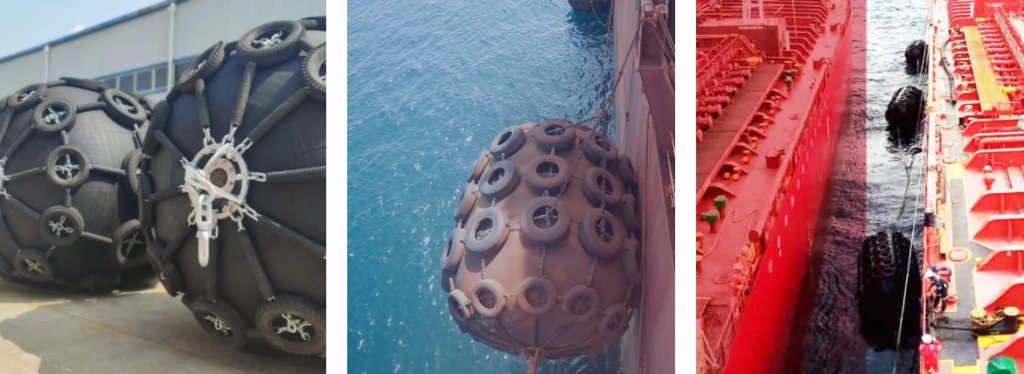¿Por qué elegir las defensas Donut para los sistemas de protección de monopilotes?
07/01/2025¿Cómo guardar los guardabarros de goma?
07/02/2025Defensas Celulares vs. Defensas Neumáticas: ¿Cuál es la más adecuada para usted?
1. Por qué es importante y por qué ahora
Los incidentes de colisión y el aumento de los costes de mantenimiento están obligando a los operadores de buques y puertos a replantearse la elección de las defensas. Imaginemos una concurrida terminal de cruceros en San Francisco, donde los cambios de marea y el elevado tráfico intensifican la demanda de defensas marinas. Elegir la opción equivocada -por ejemplo, una defensa celular mal adaptada al movimiento constante- provoca un desgaste prematuro, costosas sustituciones y retrasos operativos. Con presupuestos ajustados y tiempos de inactividad caros, la elección de la defensas marinas y defensas para barcos es urgente.
2. Comparación rápida
Defensas celulares: Cilindros de caucho con cámaras huecas: excelente absorción de energía y baja fuerza de reacción, ideales para amarres de gran resistencia.
Defensas Neumáticas: Unidades hinchables tipo Yokohama-adaptables, flotan libremente, asequibles a corto plazo, perfectas para STS y mareas variables.
3. Profundizar en cada tipo
Defensas celulares: Alta resistencia y absorción de energía
- Alto rendimiento y durabilidad: Las defensas celulares presentan "una absorción de energía superior y fuerzas de reacción bajas", lo que las hace ideales para terminales petrolíferas, puertos de contenedores y operaciones con GNL.
- Baja presión del casco: Su diseño de célula hueca ofrece una distribución uniforme de la carga por todo el casco y la litera.
- Construcción robusta: Resistente a la intemperie, los rayos UV y la abrasión, ideal para instalaciones permanentes.

Defensas neumáticas: Flexibles y rentables
- Portátil y fácil de desplegar: Se hincha y deshincha con facilidad, ideal para atraques temporales o amarres de emergencia.
- Fuerza de reacción suave, compatible con STS: Excelente amortiguación durante las transferencias de barco a barco y los grandes cambios de marea.
- Económico: Suele costar aproximadamente ⅓ menos que las unidades de espuma o celdas del mismo tamaño.

4. Ventajas e inconvenientes
| Característica | Defensa celular | Defensa neumática |
|---|---|---|
| Absorción de energía | Muy alto, ideal para atraques pesados | Alta, pero ligeramente menos eficiente por tamaño |
| Fuerza de reacción | Bajo y constante | Muy bajo con cargas ligeras; aumenta bajo carga |
| Durabilidad | Excelente y larga vida útil | Bueno, pero vulnerable a los pinchazos |
| Mantenimiento | Controles visuales; mantenimiento poco frecuente | Comprobación anual del inflado; reparación de pinchazos |
| Coste inicial | Mayor inversión inicial | Rentable |
| Portabilidad | Instalación fija | Fácilmente transportable y reutilizable |
5. ¿Cuál elegir?
Elija Defensas celulares si lo necesitas:
- Instalaciones de larga duración en terminales con mucho tráfico
- Manipulación de grandes buques (graneleros, contenedores, petroleros)
- Mínima presión sobre el casco y rendimiento constante
Opta por Defensas Neumáticas si quieres:
- Flexibilidad para operaciones entre buques o emergencias
- Solución asequible a corto y medio plazo
- Opciones de despliegue rápido para condiciones de marea cambiantes
6. Recapitulación
Seleccionar el defensas para barcos o defensas marinas se reduce a las necesidades operativas. Elija defensas celulares por su solidez y rendimiento en instalaciones permanentes; opte por defensas neumáticas para una flexibilidad y portabilidad rentables. NANHAI se especializa en ambos, y está preparada para ayudarle a encontrar la solución perfecta para las necesidades de su muelle.
PREGUNTAS FRECUENTES
1. ¿Para qué sirven las defensas marinas?
Las defensas marinas protegen las embarcaciones, los buques y las infraestructuras portuarias absorbiendo y disipando la energía cinética durante el atraque, lo que evita daños tanto en los cascos como en las estructuras.
2. ¿Son mejores las defensas celulares que las neumáticas?
Las defensas celulares destacan en instalaciones fijas, manipulando buques pesados con alta absorción de energía y baja fuerza de reacción. Las defensas neumáticas ofrecen flexibilidad, portabilidad y menor coste, lo que las hace ideales para operaciones entre buques y variaciones de las mareas.
3. ¿Cómo funcionan las defensas neumáticas (Yokohama)?
Absorben el impacto mediante aire comprimido en un cuerpo de caucho. Su baja fuerza de reacción con una ligera desviación los hace ideales para operaciones de carga líquida y transferencias STS.
4. ¿Cuál es la vida útil de las defensas celulares?
Las defensas de celda fija suelen durar entre 10 y 20 años, en función de la frecuencia de atraque y la exposición ambiental.
5. ¿Pueden utilizarse conjuntamente defensas celulares y neumáticas?
Sí, a menudo se combinan: defensas celulares para el atraque permanente, con defensas neumáticas añadidas para operaciones flexibles, temporales o de buque a buque.
Si desea más información sobre defensas marinas, defensas para barcoso soluciones de NANHAI!
